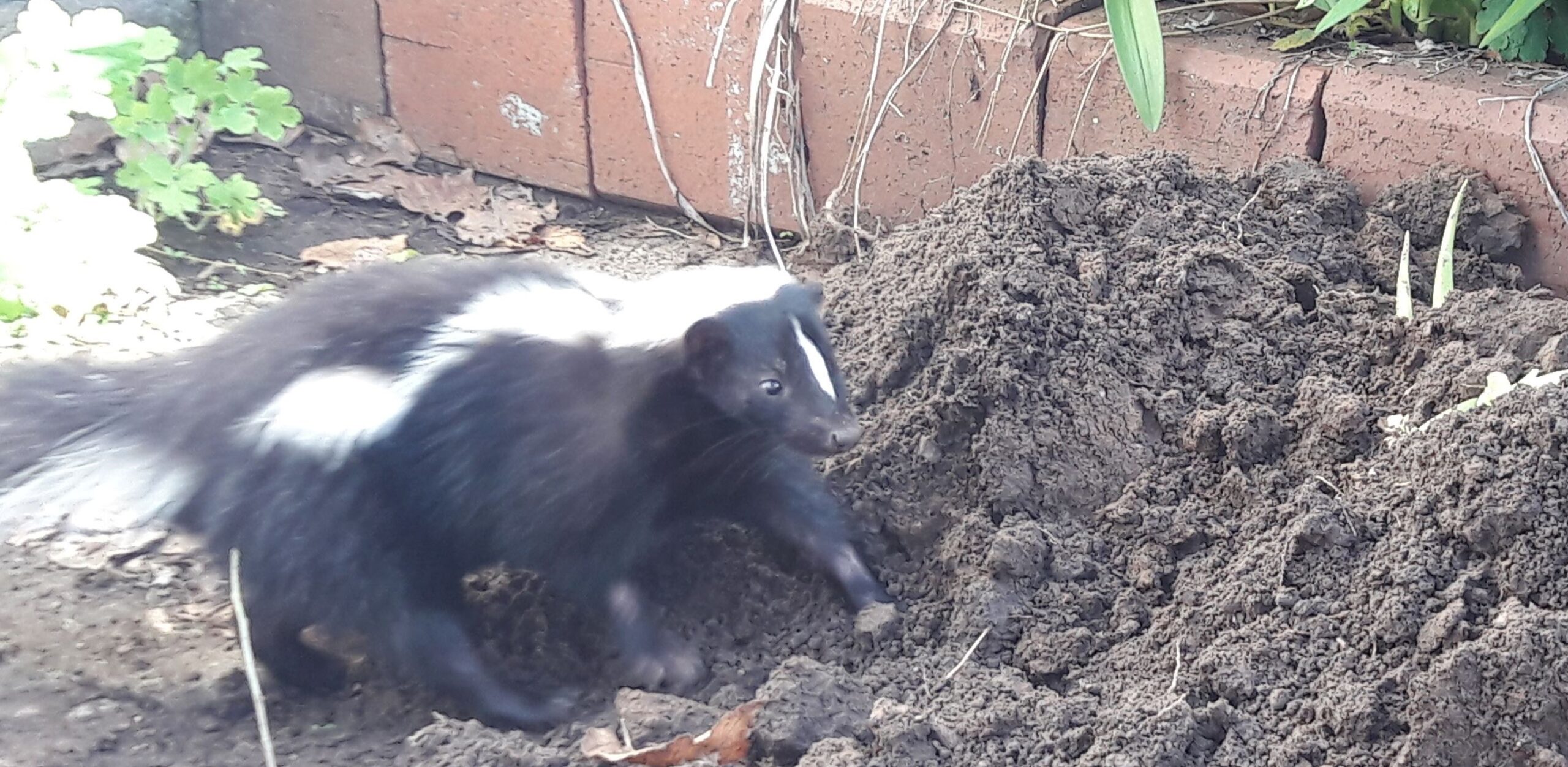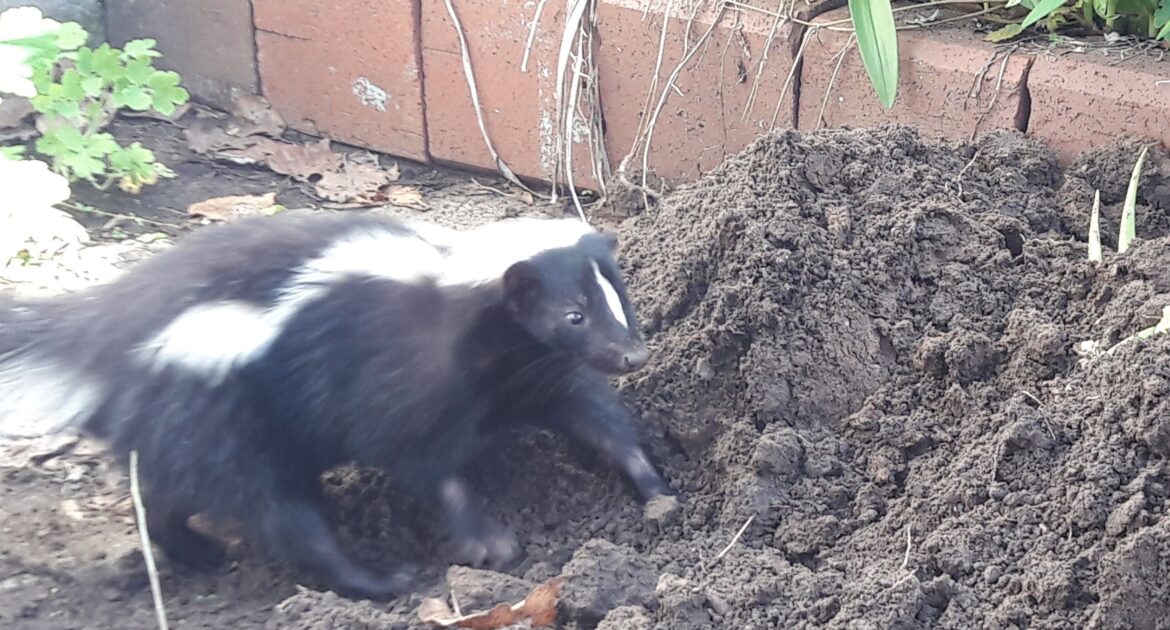When the sun sets in Columbus, many homeowners believe that’s when their wildlife concerns begin – especially with skunks. As residents near the Ohio State University campus and throughout New Albany can attest, spotting these distinctive black and white creatures can cause immediate concern. But are skunks strictly nocturnal animals that only emerge under cover of darkness, or is their activity more complex than it seems?
At Skedaddle Humane Wildlife Control, we frequently field questions about when skunks are most active. Understanding the behavior of these animals is essential for effectively managing potential encounters and protecting your property. Let’s explore the truth behind their activity patterns and what residents should know about these often-misunderstood mammals.
Are Skunks Nocturnal? The Truth About Their Activity Patterns
The short answer is yes—skunks are primarily nocturnal animals. Their biology is adapted for nighttime activity, with specialized vision that performs better in low-light conditions. Most skunks begin their daily routine at dusk and remain active throughout the night while we’re sleeping.
However, this doesn’t mean they strictly follow a nocturnal schedule. Several factors can influence their activity:
- Seasonal changes affect behavior, with different patterns emerging throughout the year.
- Reproductive status can alter activity, especially for mother skunks with young kits.
- Food availability drives much of their behavior and can override their natural nocturnal tendencies.
- Human development and urbanization have forced them to adapt their natural patterns.
This flexibility in their activity schedule is why homeowners sometimes spot skunks during daylight hours—a sight that often causes unnecessary alarm. Understanding the reasons behind daytime skunk activity can help you better assess the situation.
Daytime Skunk Sightings: What They Mean
Contrary to popular belief, seeing a skunk during daylight hours doesn’t automatically indicate that the animal is sick or rabid. There are several normal reasons why these primarily nocturnal creatures might be out during the day:
Hunger and Food Scarcity
When food resources are limited, these animals may extend their foraging time into daylight hours. This is especially true during:
- Late winter/early spring when natural food sources are depleted after hibernation-like periods.
- Drought conditions when insects and other food sources become scarce.
- Urban environments where competition for food is high among wildlife.
In neighborhoods with extensive landscaping or properties backing up to wooded areas, skunks may venture out during the day to take advantage of available food sources like grubs in lawns or fallen fruit.
Mating Season Activity
During the breeding season (typically February to March), male skunks may become more active during all hours as they search for potential mates. This increased activity can sometimes lead to daytime sightings as they expand their territory and travel farther than usual.
Mother Skunks with Young
Perhaps the most common reason for daytime skunk activity is maternal behavior. Between May and June, mother skunks give birth to litters of typically four to seven kits. These baby skunks require substantial nourishment, forcing mothers to forage more frequently—sometimes during daylight hours.
Mothers often need to feed themselves and their growing babies, which may require them to hunt during the day. As the kits grow, mothers take them on short foraging trips to teach survival skills, and these outings sometimes occur during dawn or dusk, extending into daylight hours.
Seasonal Skunk Activity Patterns in Columbus
Skunk behavior changes significantly throughout the year, following seasonal patterns that Columbus residents should be aware of:
Spring Activity (March-May)
Spring marks the end of the skunks’ period of winter inactivity and the beginning of their most active season. During this time:
- Mating season concludes, and pregnant females seek safe denning sites.
- They increase their foraging activity, often digging in lawns for grubs and insects.
- Property damage may occur as skunks create new dens under structures like decks and sheds.
For homeowners in New Albany and surrounding areas, spring is when you’re most likely to notice signs of skunk activity, including small holes in your lawn and garden.
Summer Behavior (June-August)
Summer is perhaps the busiest time for skunks in Ohio:
- Mothers lead their now-mobile kits through neighborhoods.
- Young skunks begin learning to forage independently.
- Families may create multiple den sites to escape summer heat.
- Digging activity increases dramatically as the soil becomes softer.
One skunk can move surprising amounts of soil in a short time, potentially causing damage to structures. If you notice freshly disturbed soil along your deck or shed, it could indicate a skunk has moved in.
Fall Preparation (September-November)
As temperatures drop, skunk activity patterns shift toward preparation for winter:
- Skunks focus on building fat reserves, often increasing foraging time.
- New den sites are established for winter shelter.
- Young skunks begin to disperse and establish their own territories.
- Digging activity increases as they prepare winter dens.
Fall removal is particularly important because once winter arrives, skunks will settle into their dens for extended periods, making removal more challenging.
Winter Dormancy (December-February)
While not true hibernators, skunks do enter a state of dormancy during winter:
- They remain in their dens for extended periods.
- They experience reduced body temperature and metabolic rate.
- They occasionally emerge during warm spells to find food and water.
- They conserve energy by sleeping for up to 20 hours per day.
Recognizing Signs of Skunk Activity On Your Property
Whether they’re active day or night, skunks leave distinctive evidence of their presence. Here’s what homeowners should watch for:
- Distinctive holes: Small, cone-shaped holes in lawns roughly 3-4 inches in diameter (from grub hunting).
- Digging evidence: Disturbed soil and tunneling along foundations, decks, and sheds.
- Track patterns: Five-toed footprints resembling those of a small raccoon but with visible claw marks.
- Strong odor: The unmistakable smell of skunk spray, even without direct spraying.
- Nighttime sightings: Frequent skunk observations on your property during evening hours.
Unlike some wildlife, multiple skunks may share larger den sites, especially in winter, meaning one sighting could indicate a larger population under your deck or shed.
Managing Skunk Encounters Safely
When skunk activity patterns bring these animals into contact with humans, knowing how to respond is crucial:
If You Encounter a Skunk
- Remain calm and still if the skunk hasn’t noticed you.
- Back away slowly without making sudden movements.
- Watch for warning signs like foot stamping or a raised tail.
- Avoid loud noises or quick gestures that might startle the animal.
- Keep pets indoors or on leashes during prime skunk activity times.
Preventing Unwanted Skunk Residents
Making your property less appealing to skunks is the first line of defense:
- Secure potential food sources by using wildlife-resistant trash containers.
- Remove fallen fruit from trees and gardens promptly.
- Treat lawns for grubs, which are a primary food source.
- Install motion-activated lights in dark areas around your property.
- Use preventative barriers around potential den sites before skunks move in.
When to Seek Professional Skunk Management
While understanding skunk behavior helps, certain situations require professional intervention. Contact wildlife specialists when skunks have established dens under your structures or if you notice skunk families with young kits. Addressing the problem early can prevent more significant issues and ensure the safety of both the skunks and your property.
If you’re noticing signs of skunk activity, contact Skedaddle today. Our expert team in Columbus is equipped to safely manage skunk encounters, ensuring your home remains secure from these persistent visitors.




